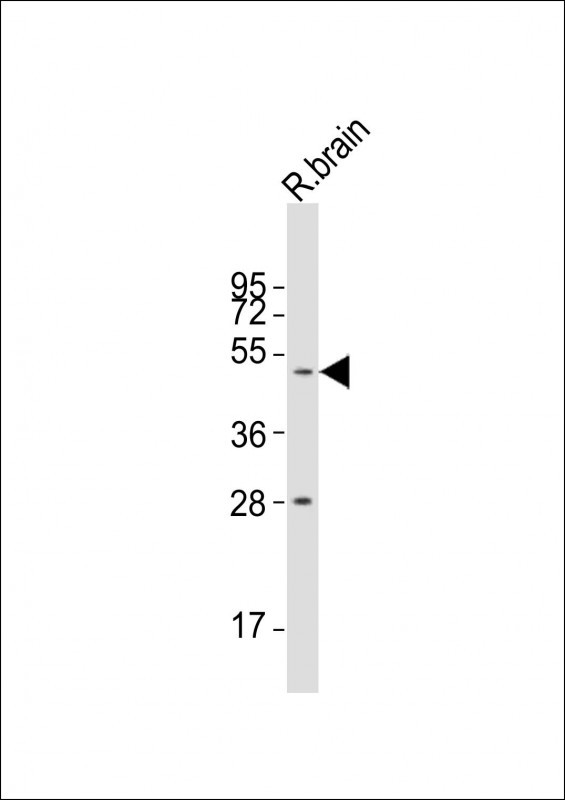KCNJ10 Antibody (Center)
Affinity Purified Rabbit Polyclonal Antibody (Pab)
- 产品详情
- 实验流程
- 背景知识
Application
| WB, E |
|---|---|
| Primary Accession | P78508 |
| Other Accession | P49655, Q9JM63, NP_002232.2 |
| Reactivity | Human, Rat, Mouse |
| Predicted | Mouse, Rat |
| Host | Rabbit |
| Clonality | Polyclonal |
| Isotype | Rabbit IgG |
| Calculated MW | 42508 Da |
| Antigen Region | 203-230 aa |
| Gene ID | 3766 |
|---|---|
| Other Names | ATP-sensitive inward rectifier potassium channel 10, ATP-dependent inwardly rectifying potassium channel Kir41, Inward rectifier K(+) channel Kir12, Potassium channel, inwardly rectifying subfamily J member 10, KCNJ10 |
| Target/Specificity | This KCNJ10 antibody is generated from rabbits immunized with a KLH conjugated synthetic peptide between 203-230 amino acids from the Central region of human KCNJ10. |
| Dilution | WB~~1:1000 E~~Use at an assay dependent concentration. |
| Format | Purified polyclonal antibody supplied in PBS with 0.09% (W/V) sodium azide. This antibody is purified through a protein A column, followed by peptide affinity purification. |
| Storage | Maintain refrigerated at 2-8°C for up to 2 weeks. For long term storage store at -20°C in small aliquots to prevent freeze-thaw cycles. |
| Precautions | KCNJ10 Antibody (Center) is for research use only and not for use in diagnostic or therapeutic procedures. |
| Name | KCNJ10 (HGNC:6256) |
|---|---|
| Function | May be responsible for potassium buffering action of glial cells in the brain (By similarity). Inward rectifier potassium channels are characterized by a greater tendency to allow potassium to flow into the cell rather than out of it (PubMed:8995301). Their voltage dependence is regulated by the concentration of extracellular potassium; as external potassium is raised, the voltage range of the channel opening shifts to more positive voltages (PubMed:8995301). The inward rectification is mainly due to the blockage of outward current by internal magnesium. Can be blocked by extracellular barium and cesium (PubMed:8995301). In the kidney, together with KCNJ16, mediates basolateral K(+) recycling in distal tubules; this process is critical for Na(+) reabsorption at the tubules (PubMed:24561201). |
| Cellular Location | Membrane; Multi- pass membrane protein. Basolateral cell membrane. Note=In kidney distal convoluted tubules, located in the basolateral membrane where it colocalizes with KCNJ16. |
| Tissue Location | Expressed in kidney (at protein level) (PubMed:24561201). In the nephron, expressed in the distal convoluted tubule, the connecting tubule, the collecting duct and cortical thick ascending limbs (PubMed:20651251). |
For Research Use Only. Not For Use In Diagnostic Procedures.
Provided below are standard protocols that you may find useful for product applications.
BACKGROUND
This gene encodes a member of the inward rectifier-type potassium channel family, characterized by having a greater tendency to allow potassium to flow into, rather than out of, a cell. The encoded protein may form a heterodimer with another potassium channel protein and may be responsible for the potassium buffering action of glial cells in the brain. Mutations in this gene have been associated with seizure susceptibility of common idiopathic generalized epilepsy syndromes.
REFERENCES
Jonard, L., et al. Int. J. Pediatr. Otorhinolaryngol. 74(9):1049-1053(2010)
Reichold, M., et al. Proc. Natl. Acad. Sci. U.S.A. 107(32):14490-14495(2010)
Heuser, K., et al. Epilepsy Res. 88(1):55-64(2010)
Pawelczyk, M., et al. Ann. Hum. Genet. 73 (PT 4), 411-421 (2009) :
Yang, T., et al. Am. J. Hum. Genet. 84(5):651-657(2009)
终于等到您。ABCEPTA(百远生物)抗体产品。
点击下方“我要评价 ”按钮提交您的反馈信息,您的反馈和评价是我们最宝贵的财富之一,
我们将在1-3个工作日内处理您的反馈信息。
如有疑问,联系:0512-88856768 tech-china@abcepta.com.























 癌症的基本特征包括细胞增殖、血管生成、迁移、凋亡逃避机制和细胞永生等。找到癌症发生过程中这些通路的关键标记物和对应的抗体用于检测至关重要。
癌症的基本特征包括细胞增殖、血管生成、迁移、凋亡逃避机制和细胞永生等。找到癌症发生过程中这些通路的关键标记物和对应的抗体用于检测至关重要。 为您推荐一个泛素化位点预测神器——泛素化分析工具,可以为您的蛋白的泛素化位点作出预测和评分。
为您推荐一个泛素化位点预测神器——泛素化分析工具,可以为您的蛋白的泛素化位点作出预测和评分。 细胞自噬受体图形绘图工具为你的蛋白的细胞受体结合位点作出预测和评分,识别结合到自噬通路中的蛋白是非常重要的,便于让我们理解自噬在正常生理、病理过程中的作用,如发育、细胞分化、神经退化性疾病、压力条件下、感染和癌症。
细胞自噬受体图形绘图工具为你的蛋白的细胞受体结合位点作出预测和评分,识别结合到自噬通路中的蛋白是非常重要的,便于让我们理解自噬在正常生理、病理过程中的作用,如发育、细胞分化、神经退化性疾病、压力条件下、感染和癌症。







